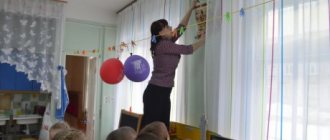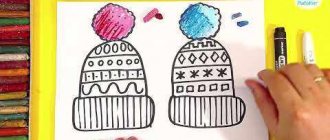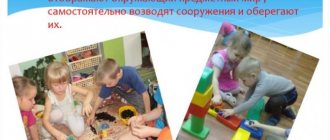Examples of construction games for kindergarten
Children play with story constructors with great pleasure. Such sets allow you to build buildings of a certain nature in the form of a farm, a palace, an Egyptian pyramid.
In senior and preparatory groups
games are made more complex by the use of building materials with different methods of fastening. Having mastered the floor construction set, older children are interested in using building materials with a more complex method of fastening. They can easily cope with ceramic and metal construction sets.
A new technique is also used - design using flat geometric shapes, including paper. Children aged 4-7 years learn, using symbolic means, to create artistic images from their environment and convey an emotional attitude towards them.
Educational children's construction game for children from 3 years old
Floor building constructor, for example, constructor of JLLC PP "Polesie".
Junior group
Purpose of the game:
- Teach to compare, observe, distinguish, remember color and shape.
The teacher introduces the kids to the names of the construction set parts: cube, brick, plate, cylinder, prism.
Pays attention to color, what details are beautiful - red, yellow, blue, green.
A game:
1. The teacher shows the details one by one - the children name them together. 2. At the request of the teacher, children find parts of the same shape (for example, a cylinder) or the same color (red or blue) 3. “Monkey”. Children repeat after the teacher. He took two parts, the children take the same ones. The teacher builds a tower or a house - the kids repeat.
The buildings gradually become more complex.
Middle group
Purpose of the game:
- Develop creative imagination, aesthetic perception, artistic taste.
- Teach to follow the sequence of actions.
- Expand your vocabulary: names of geometric shapes, spatial relationships. (Higher - lower, longer - shorter, right - left).
The teacher talks about the noble work of the builders, what beautiful structures they build. Children get acquainted with illustrations of architectural structures.
A game.
The group turns into a construction bureau, which is given tasks to build: a tall house with two apartments, a long path leading to it; a garage with a low fence and so on.
Senior and preparatory groups
Purpose of the game:
- Formation of independence, active thinking, development of efficiency, constructive and creative abilities, correct relationships in a friendly team.
- Development of coordination of movements and eye.
- Construction of the simplest buildings according to drawings drawn by adults, or according to options in the “Construction” section of the preschool general education program.
A game.
Children learn to do work according to plan. The teacher draws a plan - for example, a room, a yard or a house. Introduces the children to the plan and puts it away. The task is to create from memory the teacher’s idea from the parts of a building set.
Construction game “My house is made of bricks”
The basics of building houses from building kits.
For younger children
Purpose of the game.
- Reinforce the concepts: big - small, low - tall.
- Teach techniques for building houses for your favorite fairy-tale characters.
Material:
- bricks,
- cubes,
- triangular prisms.
The teacher, using a counting rhyme, divides the children into two teams: the house builders and its residents (cat, mouse, dog).
A game.
1. The teacher shows the “builders” how to properly build houses for their little friends and says:
- I’ll take two cubes and put them close. I'll put a roof on them - there will be a house for the pussy.
He puts two cubes next to each other and a roof on top - a triangular prism - and invites her pussy to the housewarming party. Here everyone unanimously notices that the house is very small and only a mouse can fit in it. The mouse is congratulated on his housewarming.
2. How to build a bigger house for a cat? The teacher places the bricks on edge parallel to each other, with two parallel prisms on top.
Sentences:
- Let's take two bricks and put them edge-on. Let's put two prisms on their faces - the roof will be higher. Be a good cat - quickly jump into a new home!
1. The teacher suggests building a house for the foal.
- This house is very simple - We will put the bricks in height. Let's cover everything with a roof - So the house is out!
2. The teacher shows how you can build a house for a dog.
The dog doesn’t want to be homeless, we’ll build him a comfortable house!
Two bricks are placed vertically close together. There are also two bricks in parallel at a distance. Two parallel prisms are laid to form a roof. They show how to make a window: a brick is placed on a narrow edge and the wide side is placed against the house.
Summary of OOD designing “House” in the senior group
Summary of GCD
Educational area:
design
Topic: “At Home”
Age group:
senior
Goal:
to introduce children to different types of houses and parts of the house;
increase knowledge about house designs. Objectives:
- To teach children to navigate the types of residential buildings, to consolidate the ability to build according to the proposed plan-scheme, to continue to teach children to compose creative stories and complex common sentences.
— Develop thinking, creative imagination, fine motor skills. — To instill in children respect for the work of builders; cultivate a caring attitude towards your home. Materials:
paintings of houses, small and large building materials (Legos, blocks), foundation diagrams.
Vocabulary work
: kitchen, bathroom, hall, hallway, hollow, hole, multi-story house, one-story house.
Progress Educator:
Hello, guys!
Today is a very good day! Even though it’s cold late autumn outside, it’s warm and cozy in our group. Is it also cozy and warm in the forest? Where do animals hide from the cold? (children’s answers). The dwellings where animals live are called differently. Educator:
Let's remember again where the animals live.
I will read the beginning of the poem, and you will finish it: The bear lives in ... (den), Fox, badger - in ... (hole), Beaver built ... (hut), Squirrel lives in ... (hollow), Mole under ... (ground) ) huddles - There he is with his whole family. Where do you and I live? Who can tell me quickly? ( Children's answers.
)
Educator:
That's right, guys, we live in houses, in apartments.
Each of you has a home - a place where you live with your family. There are different houses and they are called differently: wooden, brick, panel. How do you understand these names? What kind of house is yours? ( Children's answers; the teacher displays pictures of houses). Educator:
Indeed, guys, you are right.
Wooden houses are houses built from wood, brick houses are made from bricks, panel houses are made from blocks. Houses can also be one-story or multi-story. How do you understand these names: one-story house, multi-story house? ( Children's answers
.)
Educator:
That's right, a house consists of one floor, a multi-story house means it consists of two or more floors.
What kind of houses do you live in? Tell me, please. (Several children talk about their home.)
Educator:
You see, guys, some of you live in an apartment in a multi-storey building, someone lives in their own house (on land, a private house)
Educator:
Guys, we have found out what a house is for and what it is like.
Please tell us what your house consists of? What's in it? How many rooms? ( Children's answers
).
Educator:
Let's imagine that we open the door, enter the house and see all this at once or not?
( Children's answers
).
( We have all this in certain places - in our rooms). Educator:
To find out what rooms there are in our houses, I suggest you solve riddles: Our mother is in this room More often, Sometimes porridge escapes from the pan here.
( Kitchen
)
What is a kitchen for? What are they doing there? ( Answers children
j)
We brush our teeth, wash our hands, and swim in the evening. Every morning we are bored, we just wash ourselves. ( Bathroom
.)
- What is a bathroom for? ( Children's answers)
Sweet dreams I always dream at night in this room. And in the morning, a ray of sun sometimes wakes me up. ( Bedroom.)
In this room, the whole family gathers together, Sometimes to have fun, Sometimes to play, Everyone watches TV Or reads books. ( Hall.)
This room welcomes everyone who comes to our house. ( Hallway
)
Educator:
Guys, you are great! All the riddles have been solved! Let's play the game “Building a House” and turn into young builders.
Physical exercise.
What does it cost us to build a house? Is there a foundation, can we live? (sat down) We build further walls (stand up) And we look out of our window (arms bent at the elbows) The roof protects us from bad weather (arms above our heads) It will cover everyone all year round.
Educator
: Guys, now let's remember what everyone has at home?
( Children's answers
).
Educator:
That's right, the house has a roof, windows, doors, a kitchen and much more. And why this is needed, we will now find out.
Educator:
Guys, today I invite you to build models of houses for our families.
Do you know what a layout is? (this is a smaller version of the buildings).
Educator:
I suggest you go to the table and take 1 sample. The foundation is the foundation of the house; it must be strong, strong, and stable. Think about it, and perhaps you will build a foundation in two rows, strengthening each other. Don't forget that the house must have windows. The more windows, the brighter the house. The house must have a roof. It can be of any shape.
Independent activity of children, during which the teacher corrects the children’s work: gives advice on building houses.
View all received houses.
Educator:
Our work is ready.
Look how many interesting houses we have created! ( Children's suggestions
).
Educator:
Tell us about the house you built: what size is your house?
What is he like outside and inside? What's unusual about it? Why would you want to live in it? ( Answers, children's stories).
Educator:
Today you and I built houses for our families.
Reflection.
What new did you learn today? What did you like?
Preview:
Construction game: “We are building a city and a village.”
Tasks:
To promote the improvement of skills in constructive activities,
Formulate a self-assessment of the final result,
Contribute to the creation of a positive emotional atmosphere,
Promote the development of coherent speech,
Carry out construction in a certain sequence,
Nurture collective relationships in the process of constructive activities.
instill patriotic feelings;
Equipment: building diagrams, attributes for construction.
Preliminary work: individual, subgroup, frontal work on the design of various buildings, construction of a city, village; familiarization with elementary mathematical concepts.
Sources: Program and technology “Kindergarten - a house of joy” by N.M. Krylova.
Progress of the lesson.
Round dance game "Cubs are playing ball."
V: Let's say hello
Motivation.
Q: Who do you think came first today?
Q: First... you came first today... Will this (doubt) be accurate? (I came first, there was no one else)
V.: It seems to me that you are second. (No, the first of the children)
V.: Why did I say that you are second?! (you can say this because you came first, and I came second)
V.: This is an inaccurate answer... In mathematics it is not allowed to count like this, the counting is inaccurate... When it can be said about us that there are TWO of us... or TWO (two people)
V.: So who is first today? (both you and me). The answer reflects an understanding of the problem.
V.: Today you and I can both call ourselves “first”... Only you will be the first... who? (Child) Yes, I will be the first (adult). And if I say that I am the first MAN, then you will?! (Second person - sounds like eureka, joyful).
V.: Go to the calendar and see if FIRST is there. (Today is December 1; December is the first month of winter, Monday is the first day of the week, January will be the first month of the year).
Q: What are the names of children who come to kindergarten? (Preschoolers)
Q: What will they call you when you go to school? (Pupils)
V.: There is this type of work - construction. What professions are people called builders? (called).
V.: Do we have building material... Can we be builders?! (Can )
Q: Where do you want to build? What material…? What are you planning? So, what happens (strangely) that every builder builds wherever he wants?! (Children must understand that a builder, like any other profession, depends on the plans of the architect, and their plans depend on the conditions of the area).
Q: Have you chosen WHAT you want to build? And who was missing so that your results of labor... and bridges, and houses, and roads, and factories would benefit people and be convenient for them?! (You need an architect..., he plans a city or a village...).
Q: But before building, what should he do? Choose a location. So, the main FIRST in construction will be the architect?!
V.: Well, in order for all the buildings and structures to be distributed, the architect needs to draw everything on the board.
V.: So, who were we yesterday? (architects)
Q: What professions of builders will we have? (Bridge builders, road builders, house builders... And we also need to build a station... And a factory... We will build a village... And we will build a dairy plant in the city).
Q:Can you come up with a game about what is drawn on the board?
V.: So, what are we up to today? (build a city and a village)
V.: Can you build it so that everyone can live comfortably, so that
the buildings were STRONG, WARM, SO THAT IT WAS COMFORTABLE... (excitingly)? (Yes ).
V.: You agree too quickly (jokingly), but can you (excitingly) build such a city?! (Can ).
V.: Probably, we need to think not only about how beautiful the city and village will be, but also where we will place them.?!
V.: Well (thinking) you can build according to the plan, like, for example, St. Petersburg was built... Or you can build it like Moscow was built... It wasn’t built all at once, but gradually... There was no plan for the layout of the streets in advance, they built around the Kremlin .
Q: How did you and I decide to build? (According to plan).
V.: In our city there is a main square, from it there is a main street. There is an entrance and a train station. Will there be a river? This is the river...
Q: YOU are architects and builders, you have individual projects, please choose.
V.: And I say: “The city will be founded here, according to this plan.”
Activity.
Grade. Built.
V.: Construction time has expired. Let's discuss the development of the city and countryside? You probably agree that it’s good for the city and village to be beautiful, comfortable, and, of course, for the buildings to be durable? (Yes)
Everyone gathered for the assessment.
Q: What country do we live in? (Russia)
Q: What are those who live in Russia called? (Russians)
Q: What city do we live in? (Kemerovo)
Q: What is the name of the city that you built? (Suggest titles)
Q: The city that you built is in what country? (In Russia )
V.: Excuse me, how to determine this? (There is a flag on the main building of the city)
Q: What else can be a symbol of the state? (Coat of arms, anthem)
(Play Russian anthem)
Q: Is it convenient for residents to live in your city? Why? (Explain).
V.: Well, so your residents only relax, but they have nowhere to work?!
Are everyone unemployed? (There is a plant).
V.: Well, if there is a plant, then, probably, someone works at the plant, which means there is a result of the work?! (They will begin to fantasize about what they produced at the factory).
Q: Where do the raw materials for the plant come from? (
Q: Where are the products sent and to whom?! Should I send it far or close?! (They reason).
Q: How should it be sent..., what transport...? It is possible, of course, by river transport, but also by rail. ., maybe by plane...?! (They argue, if they call it river transport)
Q: Do you have piers? (No, but then you can by plane).
Q: Is there an airfield? (They reason).
Q: You had everything in the stores... both vegetables and fruits? (Yes).
V.: And they just lie in the store... and don’t run out?! (They are transported). On what?
Q: Where are they unloaded? (Future buildings are called again).
V.: They took it out... and they will bring it to you... From where? (Showing village houses)
Q: Did you bring anything from there? (Called)
Q: What could be sent there from your city?
(Yes, they probably need both scythes and tractors...).
V.: Well done! You are real builders!
Those who complete the conversation either play in the built city or look at books. But most will strive to play. It will take the form of a director's play. Children will talk about nesting dolls (of different sizes), take them to shops, theaters, schools, etc. Obviously, children will be happy to play with city buildings, roads, take nesting dolls to the theater, to the store...
APPLICATION
- an important component in the upbringing and education of children. Therefore, first you need to consider some questions about constructive ones. I hope that the material I told will help you in teaching children.
What questions will we consider:
- What are constructive
- What does a child need for constructive play?
- Stages of development of constructive play
- Techniques for teaching constructive play
What it is? - this is a type where children reflect their impressions of surrounding objects, independently make various buildings, structures, buildings, roads, but do it in a schematic, generalized form. In constructive games, objects are replaced by other objects, that is, buildings are erected from special construction sets, building kits, and natural materials. That is why constructive games are classified as creative games. For children 3-5 years old, constructive games often take the form of role-playing games, in which children play the role of construction workers.
What does a child need for constructive play?
- The ability to create an image of an object in its spatial expression. This is how a sense of orientation in space develops, the ability to distinguish and establish the proportions and size of an object, its spatial relationships.
- The ability to evaluate and take into account the properties and quality of the materials used during construction, to anticipate and carry out a sequence of actions. Therefore, constructive games teach children to set goals and plan their actions.
- Constructive games develop in children the ability to compare and contrast the structure they created with the real objects on the basis of which the structure was built. This develops observation and attentiveness in children.
Stages of development of constructive play
- Children 3-5 years old depict single objects and small structures. The themes of their buildings are related to their role-playing games, for example, a garage for a car, a house for a doll. Their designs are very simple. Their buildings are arranged horizontally, like a drawing on paper. The same house for a doll is a certain space that is fenced off with several cubes, and on top there is some kind of plate or plank called a roof. Children at this age erect a building, then destroy it and begin to build it again. They are interested in the construction process itself, and not in the result obtained at the end of this activity. It often happens that construction is ahead of the plan: the child begins to build something, and only then recognizes some object in his construction.
- Children aged 5-7 years gradually expand the themes of buildings. They have ships, roads, bridges, buildings, cars. In their designs, children try to convey the originality of a particular structure. For example, they are building not just a house, but their own house in which they live or their own kindergarten. At this age they begin to complicate the structure itself. The buildings are growing upward. Children decorate them with columns, towers, windows, using various ceilings.
Techniques for teaching constructive play
Adults (parents and kindergarten teachers) should teach children constructive skills and abilities. Because without this, children's buildings will remain simple and primitive. There are several ways adults can teach children the skills needed for constructive play.
- Examination of objects, structures, buildings. During examination, it is necessary to draw children's attention to the purpose of the object, the features of its design, parts and their proportions. All this should be accompanied by a conversation with the children (namely a conversation, not a monologue by an adult). You can also additionally consider drawings of similar objects.
- The indirect guidance of an adult is the enrichment and updating of children’s knowledge about the objects and characteristics of the materials from which they build their buildings.
- Direct guidance is the role-playing participation of an adult in the game, explanations, and advice during the game.
Today we talked about constructive games
, about the skills that a child needs for them, about the stages of constructive development and about techniques for managing them.
If you have any additions on this issue, be sure to leave your comment.
More from my site
Date of observation: 04/24/2014



